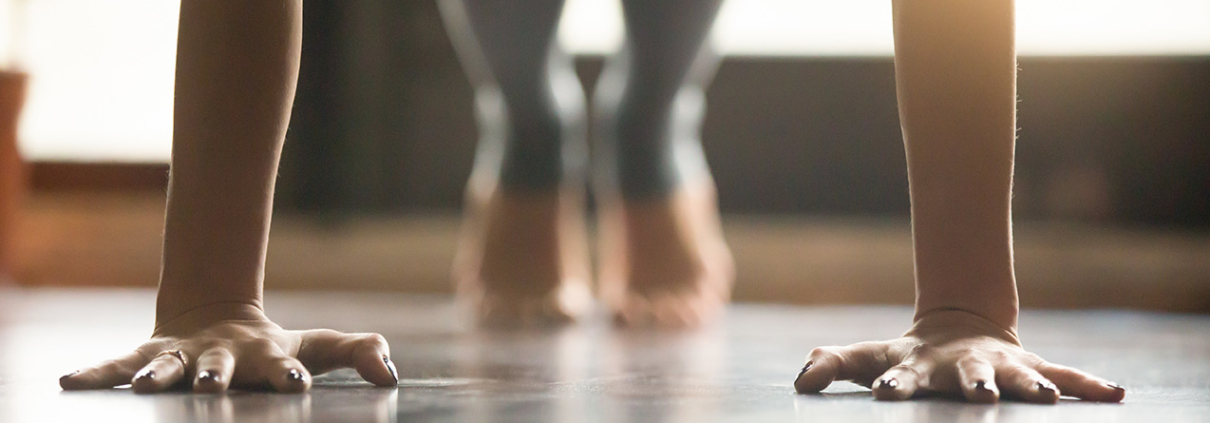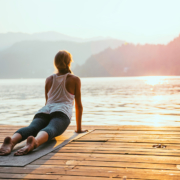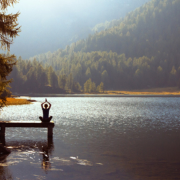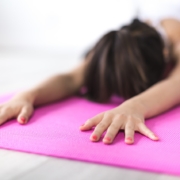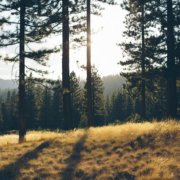My Home Practice: An Ever Unfolding Relationship
I signed up for my first yoga teacher-training program because I wanted to know what my teachers knew. I wanted to know how to practice yoga. Meaning I wanted to be able to do it by myself, without needing to go to a yoga class.
This was important to me because getting to a class was extremely difficult. Not only because I lived in a small town that had no yoga studios, but also because I was a working single mom who had very little free time to speak of. So when I signed up for teacher training I had no real thoughts of being a teacher, rather I held an image of one of my first teachers doing Yoga on the beach, self-directed and independent, completely absorbed by the effort of her practice. That was what I really wanted, and that was what I hoped I would receive from my training. I also had a vague plan of teaching in my living room one day, inviting some friends over now and then, charging them $5-10 bucks for a class, maybe one day paying off my teacher training investment., but my primary interest was in being able to access the healing joy of my practice whenever I needed to, without having to rely on anyone else.
That was sixteen years ago and I’ve taken many more teacher trainings since, but having a personal practice is still deeply important to me. My son is almost grown now and I have a supportive husband, so getting time to myself is much easier than it was before, but even still it does not always work to fit a yoga class into my schedule. In actual fact the heart of my 16+ years of relationship to practice has occurred at home, on my own mat, in a small corner of my living room. Dog hair, children’s toys and countless interruptions included.
Over the years my personal practice has gone through many shifts and changes, and yet it remains one of the most abiding relationships of my life. I actually believe that my commitment to practice has taught me how to be committed to other primary relationships, such as my relationship to myself, to my body, to my partner, and to my family, which has been an unexpected and fabulous benefit, that has brought me much insight.
As a Yoga teacher & teacher trainer I often get asked about my personal practice, so today I am devoting an entire article to it, because when I say that I have maintained a commitment to practice for over 16 years that does not mean that I have done the same practice, day in and day out, each season of the year, or each season of my life. It does not mean that at all. So let me share with you how my practice has changed, and why, as well as what has remained the same.
*This is a long article and so if you just want the bullet points you will see I have put in bold the actual content of my personal practice during each period listed below. If you want the reflections that go with it read the whole thing.
Building Tapas: My Ashtanga Years 1999-2004
My first yoga class was an Ashtanga Yoga class, and I loved it. Immediately. However I went on to take a classical Hatha Yoga teacher-training program even whilst I continued to practice Ashtanga Yoga as a student. I was fortunate enough to spend almost three years practicing Ashtanga Yoga as it was meant to be taught, Mysore Style, which was a huge blessing and instrumental in teaching me how to self direct my own practice. In Mysore style classes you are taught the Primary Series of Ashtanga, one pose at a time, and then directed to practice what you have been taught- on your own. In other words the teacher does not lead the class, but instead walks around giving pointers and further instruction to individual practitioners as needed, while each student in the class is responsible for moving through as much of the Series as they are able to, at their own pace. It is a brilliant method as it teaches you how to focus on your own experience and to use repetition in order to assess your own progression while also exploring the ways in which your body changes from day to day- even as the practice stays the same.
By doing the same practice 6 days a week I learned the value of commitment and non- attachment, the rewards that came from learning how to discipline myself to get on my mat, and the ways in which I could bring greater and greater refinement to the same set of postures. This was extremely helpful because when I moved back to the small town in which I began my yoga journey, the same small town that had no yoga studios and certainly no Ashtanga teachers, I was now able to get up each day and practice on my own without wasting a lot of time questioning what I should do, or whether I should practice at all. I just got up and did my practice. So it was in these years that I learned how to cultivate Tapas, a personal discipline and enthusiasm for practice. And I needed an abundance of that as from 2003 through most of 2004 I was practicing both Primary & Second Series and my daily practice took me 90 minutes to 2 hours to complete. Without Tapas I could never have gotten up so early and gotten all that practice in before waking my son up and getting him out the door to school in time for my day job. Never.
Looking back I can say that when first establishing a relationship to personal practice it is often true that our desire and commitment may need to have a greater quality of intensity, even ferocity. This often helps us to build momentum, break through resistance, and solidify new habits. This may not be true of everyone, but it was certainly true for me. My passion for practice was what helped me to create a lasting relationship with it. However I have also learned that over time that ferocious intensity can lead some of us to become dogmatic and rigid in regards to our practice. And so the next evolution in regards to my own practice was to learn how to maintain commitment, without attachment.
- Daily Practice: 90 -120 minutes of asana, brief meditation & Savasana. 6 days a week, take rest on Saturdays, Full, & New Moons. 3 years studio practice, 2 years home practice only.
Finding Flow: My Vinyasa Years 2004-2007
Though I loved to practice Ashtanga Yoga I did not enjoy teaching it. My experience of teaching yoga in public classes taught me that the Primary Series was simply not accessible to the average person coming in off the street, and so despite taking teacher trainings in the Ashtanga style I only taught it for a very short period of time, and preferred instead to teach Vinyasa Yoga, inspired by my Ashtanga practice but with a greater ability to modify the practice based on who was in class on any given day. Cultivating my ability to observe and respond as yoga teacher also began to affect the choices I was making in my home practice, and during these years I opened up to exploring different approaches to personal practice.
I had fun designing practices to teach, and then doing them for myself so that I could really understand the effect of them on my own body. I began to explore a wider syllabus of poses than the ones I worked with in the Ashtanga Series, and designed home practice to help me move through this expanded syllabus on a regular basis. As I dealt with a series of injuries due to the repetitive nature of my practice I also began to explore creating modified and therapeutic sequences specific to my own needs.
This was also the first few years of my relationship with my husband, and so a time where I needed to learn how to make space for this relationship, rather than putting my practice first. For years I had had to get up between 4:30-5am in order to practice, and that meant I was passed out by 8:30pm most nights. This makes relationships with non- practitioners challenging! I would also experience a certain amount of anxiety if I hadn’t done my practice an any given day, and this meant lazy mornings off with my love were an issue, and I didn’t want them to be.
It was during this period where I needed to learn how to trust that my relationship to practice was strong and vital enough that I could miss a day, and not fall off the wagon completely. Or that doing a moderate 45 minutes of practice in the afternoon was not a failure compared to 2 hours of intense practice before dawn. Now I began to feel that my relationship to practice had matured and became stable, whereas before there was a certain fragility to it- it looked strong and disciplined on the outside but it was very dependant on specific forms & circumstances.
- Daily Practice: 45- 120 minutes of practice depending on the day, 5-6 days per week, primarily asana based, with brief meditation & pranayama practices done sporadically. Mostly home practice.
Alignment & Grace: My Anusara Years 2007-2012
I did my first Anusara Yoga workshop in 2007 and promptly fell head over heels in love. As a teacher I was blown away by the level of skill the teacher displayed, her observation skills, knowledge of sequencing, and use of refined and explicit cueing deeply impressed me and I knew I wanted to learn how to teach like that. As a student I deeply appreciated the fact that a skilful asana practice was being combined with inspirational teachings related to the philosophy of Yoga, something I loved to study but rarely had the opportunity to speak to in the context of teaching the average Yoga class. And so I began to study this style very seriously for the next five years, as a student and as a teacher. In my personal practice I gained strength and technique and my already flexible body became more balanced, some of the injuries that I had been dealing with began to heal, and I was being guided by my teachers to explore much more detailed alignment work than I had ever been taught before, which allowed me to access a greater richness in my physical practice.
And so I continued to practice a lot during these years, and I loved it. But my practice now began to include regular meditation and even more focused philosophy studies. This meant increased contemplation and increased inquiry, which in turn supported me in becoming more aware of myself. And by that I mean the whole of my life, not just the separate compartments. More than ever before I became aware of the way in which my roles as wife, teacher, mother, student, small business owner, friend, employee, sister, daughter and human being were actually all part of a seamless whole, and that in order to show up as my best self in all these arenas my practices of Yoga needed to nourish and support me, as well as challenge and inspire me.
It was during this period that I began to look at my practice less as something that I “did” at specific times and in specific places, and more as something that I showed up for, in some way, every single day. I was now coming to my formal practice with a greater desire to understand who I was, a greater desire to understand who others were, and a greater desire to know my place in this mysterious universe. I now began to live my practice more fully and to see the myriad opportunities for practice hidden within the mundane details of my everyday life. It felt like a deepening of the great adventure that I had embarked on in my very first Yoga class so many years ago.
- Daily Practice: 45- 120 minutes of practice depending on the day, 5-6 days per week, asana based, with (mostly daily) meditation, pranayama practice done sporadically. Mostly home practice, with more classes added in as there was now a Yoga studio in my town!
Churning The Ocean: My Questioning Years 2012- 2016
In 2012 Anusara Yoga ceased to be a distinct style of Yoga (for the most part), my teachers went on to explore their own relationship to practice (independent of Anusara), and I moved to a new town. In other words 2012 was a big year and had its fair share of challenges which for the most part I actually found to be exciting because my Scorpio nature loves to burn things down in order to see what might be found in the ashes. However despite my appreciation for change any true process of transformation also brings with it a lot of deep questioning, and I have certainly been doing much of that in the last four years. I have also observed this inclination towards greater questioning not only in myself, but in the larger Yoga community as well. This questioning has led us to ponder many of the difficult and uncomfortable topics related to the culture of Modern Western Yoga, and on a personal level it has led me (at times) to question whether or not there is any real world value to the work I am doing as a Yoga teacher. All of this is a good thing I think as it asks us to dig deep and figure out what we are really doing, and why.
And somewhere in the midst of all this contemplation, questioning and change, my practice has shifted once again. It now seems to be less focused on asana and includes more meditation, mantra, and prayer than ever before. Which is interesting as I still love my asana practice, and I still get great benefit from it, I am just doing less of it.
So why am I doing less asana? Well one thing I want to make clear right away is that I did not write this great long article to put forth the idea that doing less asana and doing more meditation represents some kind of spiritual evolution on my part. I am not trying to suggest that I have somehow shifted into some higher level of understanding where I can now see my asana practice was only ever a mere stepping-stone to more exalted practices. This is not what I am saying at all. Actually I hate it when teachers talk like that, holier than thou and dripping with judgment for all those un-enlightened beings who still need to move their body in order to feel alive, yuck. No, that is not the point I am trying to make here.
Rather I am simply reflecting on the fact that I seem to have lost any sense of ambition in relationship to my asana practice, if any ever existed at all. I never had serious”pose lust” as a student, and I am not competitive in any way, but I definitely felt a certain sense of wanting to “get it” when it came to asana. I wanted to understand and to know everything I possibly could about the practice. And now perhaps I simply feel more at peace with what I do understand, what I do know, and what I have received. Not that I think there is nothing more to learn either, only that I don’t seem to need to do 1-2 hours of asana 5-6 days per week in order to learn it at this point. Nor am I doing less asana due to injury or limitation, my practice feels great when I do it, it’s just that I am completely satisfied with less of it these days.
Certainly there were times in the last couple years where I did wonder if I was done with asana, bored of it somehow, but then I realized I am not actually bored at all. Because with boredom comes a restless searching for something else to fill the gap and that is not what is happening here, I am simply making space for other interests and enjoying asana as one of many practices that enrich my life, not the only practice. I recognize that many practitioners (including myself) could benefit from doing some work around letting go the self-judgment that arises when we measure our practice, or ourselves, by how much asana we are currently doing. But really that is so useless. I believe that each of us needs to do only as much asana as is necessary or enjoyable for our unique bodies in the given season of our lives, and that part of our greater practice is to remain open and responsive to the ways in which our practice wants to change and shift as we do. Because in the end it is the quality of the relationship we have with practice itself that matters, not the form of the practice itself. So what does my daily practice look like now?
Daily Practice: 30 minutes of early morning Mantra, meditation & prayer, 45-90 minutes asana 1-3 times per week, daily study, daily creativity in the form of writing, creating program material, or doing arts & crafts of some kind. Daily dog walks, daily nature worship, daily emphasis on connection (with friends and/or family). Mostly home practice, though many of these practices can be done in studios, in the forest or with friends, which is lovely.
And so finally I just want to say that I don’t believe in anyone else giving another person a prescription for practice, though certainly it can be helpful to explore what has worked for others and be open to trying new things as we seek to understand what it is that works for us. I share my own journey with personal practice for the same reason I share most things, because I am a teacher, because I have been asked about it so many times before, and because in the sharing I hope that others will find insight. If my practice has taught me anything it is that everything always changes and nothing stays the same. It has also taught me that if I keep showing up for some form of practice each day, and I approach that practice with curiosity and reverence, without judgement, it will take me far. It already has.
